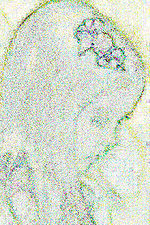
Compression artifact
Encyclopedia


Video
Video is the technology of electronically capturing, recording, processing, storing, transmitting, and reconstructing a sequence of still images representing scenes in motion.- History :...
) caused by the application of lossy data compression
Lossy data compression
In information technology, "lossy" compression is a data encoding method that compresses data by discarding some of it. The procedure aims to minimize the amount of data that need to be held, handled, and/or transmitted by a computer...
.
Lossy data compression involves discarding some of the media's data so that it becomes simplified enough to be stored within the desired disk space
File size
File size measures the size of a computer file. Typically it is measured in bytes with a prefix. The actual amount of disk space consumed by the file depends on the file system....
(known as a data rate or bit rate
Bit rate
In telecommunications and computing, bit rate is the number of bits that are conveyed or processed per unit of time....
for media that is streamed). If the compressor could not reproduce enough data in the compressed version to reproduce the original, the result is a diminishing of quality, or introduction of artifacts. Alternatively, the compression algorithm
Algorithm
In mathematics and computer science, an algorithm is an effective method expressed as a finite list of well-defined instructions for calculating a function. Algorithms are used for calculation, data processing, and automated reasoning...
may not be intelligent enough to discriminate between distortions of little subjective importance and those which may be objectionable to the viewer.
Compression artifacts occur in many common media such as DVD
DVD
A DVD is an optical disc storage media format, invented and developed by Philips, Sony, Toshiba, and Panasonic in 1995. DVDs offer higher storage capacity than Compact Discs while having the same dimensions....
s, common computer file formats such as JPEG
JPEG
In computing, JPEG . The degree of compression can be adjusted, allowing a selectable tradeoff between storage size and image quality. JPEG typically achieves 10:1 compression with little perceptible loss in image quality....
, MP3
MP3
MPEG-1 or MPEG-2 Audio Layer III, more commonly referred to as MP3, is a patented digital audio encoding format using a form of lossy data compression...
, or MPEG files, and some alternatives to the compact disc, such as Sony's
Sony
, commonly referred to as Sony, is a Japanese multinational conglomerate corporation headquartered in Minato, Tokyo, Japan and the world's fifth largest media conglomerate measured by revenues....
MiniDisc
MiniDisc
The disc is permanently housed in a cartridge with a sliding door, similar to the casing of a 3.5" floppy disk. This shutter is opened automatically by a mechanism upon insertion. The audio discs can either be recordable or premastered. Recordable MiniDiscs use a magneto-optical system to record...
format. Uncompressed media (such as on Laserdisc
Laserdisc
LaserDisc was a home video format and the first commercial optical disc storage medium. Initially licensed, sold, and marketed as MCA DiscoVision in North America in 1978, the technology was previously referred to interally as Optical Videodisc System, Reflective Optical Videodisc, Laser Optical...
s, Audio CD
Red Book (audio CD standard)
Red Book is the standard for audio CDs . It is named after one of the Rainbow Books, a series of books that contain the technical specifications for all CD and CD-ROM formats.The first edition of the Red Book was released in 1980 by Philips and Sony; it was adopted by the Digital Audio Disc...
s, and WAV
WAV
Waveform Audio File Format , is a Microsoft and IBM audio file format standard for storing an audio bitstream on PCs...
files) or losslessly compressed
Lossless data compression
Lossless data compression is a class of data compression algorithms that allows the exact original data to be reconstructed from the compressed data. The term lossless is in contrast to lossy data compression, which only allows an approximation of the original data to be reconstructed, in exchange...
media (such as FLAC
FLAC
FLAC is a codec which allows digital audio to be losslessly compressed such that file size is reduced without any information being lost...
or PNG) do not suffer from compression artifacts.
The minimization of perceivable artifacts is a key goal in implementing a lossy compression algorithm. However, artifacts are occasionally intentionally produced for artistic purposes, a style known as glitch art or datamoshing.
Technically speaking, a compression artifact is a particular class of data error that is usually the consequence of quantization
Quantization (signal processing)
Quantization, in mathematics and digital signal processing, is the process of mapping a large set of input values to a smaller set – such as rounding values to some unit of precision. A device or algorithmic function that performs quantization is called a quantizer. The error introduced by...
in lossy data compression. Where transform coding
Transform coding
Transform coding is a type of data compression for "natural" data like audio signals or photographic images. The transformation is typically lossy, resulting in a lower quality copy of the original input....
is used, they typically assume the form of one of the basis function
Basis function
In mathematics, a basis function is an element of a particular basis for a function space. Every continuous function in the function space can be represented as a linear combination of basis functions, just as every vector in a vector space can be represented as a linear combination of basis...
s of the coder's transform space.
Images

Quantization (signal processing)
Quantization, in mathematics and digital signal processing, is the process of mapping a large set of input values to a smaller set – such as rounding values to some unit of precision. A device or algorithmic function that performs quantization is called a quantizer. The error introduced by...
, as in JPEG-compressed images, several types of artifacts can appear.
- Ringing
- Contouring
- Posterizing
- Staircase noise along curving edges
- Blockiness in "busy" regions (sometimes called quilting or checkerboarding)
Image artifact reduction
Various approaches have been proposed to reduce the effects of image compression, but in order to utilize standardized compression/decompression techniques and to retain the benefits of the compression (for instance, lower transmission and storage costs), many of these methods have focused on "post-processing"—that is, processing the images when they are received or viewed. No post-processing technique has been shown to improve image quality in all cases; consequently, none has garnered widespread acceptance, though some have been implemented and are in use in proprietary systems. Many photo editing programs, for instance, have proprietary JPEG artifact reduction algorithms built-in, including Paint Shop Pro.Video
When motion prediction is used, as in MPEG-1MPEG-1
MPEG-1 is a standard for lossy compression of video and audio. It is designed to compress VHS-quality raw digital video and CD audio down to 1.5 Mbit/s without excessive quality loss, making video CDs, digital cable/satellite TV and digital audio broadcasting possible.Today, MPEG-1 has become...
, MPEG-2
MPEG-2
MPEG-2 is a standard for "the generic coding of moving pictures and associated audio information". It describes a combination of lossy video compression and lossy audio data compression methods which permit storage and transmission of movies using currently available storage media and transmission...
or MPEG-4
MPEG-4
MPEG-4 is a method of defining compression of audio and visual digital data. It was introduced in late 1998 and designated a standard for a group of audio and video coding formats and related technology agreed upon by the ISO/IEC Moving Picture Experts Group under the formal standard ISO/IEC...
, compression artifacts tend to remain on several generations of decompressed frames, and move with the optic flow of the image, leading to a peculiar effect, part way between a painting effect and "grime" that moves with objects in the scene.
Data errors in the compressed bit-stream can lead to errors similar to large quantization errors, or can disrupt the parsing of the data stream entirely for a short time, leading to "break-up" of the picture. Where gross errors have occurred in the bit-stream, decoders continue to apply updates to the damaged picture for a short interval, creating a "ghost image" effect, until receiving the next independently compressed frame. In MPEG picture coding, these are known as "I-frames", with the 'I' standing for "intra".
Mosquito noise
Video compression artifacts include cumulative results of compression of the comprising still images, for instance ringing or other edge busyness in successive still images appear in sequence as a shimmering blur of dots around edges, called mosquito noise, as they resemble mosquitoes swarming around the object.Audio
Lossy audio compression typically works with a psychoacoustic model—a model of human hearing perception. Lossy audio formats typically involve the use of a time/frequency domain transform, such as a modified discrete cosine transformModified discrete cosine transform
The modified discrete cosine transform is a Fourier-related transform based on the type-IV discrete cosine transform , with the additional property of being lapped: it is designed to be performed on consecutive blocks of a larger dataset,...
. With the psychoacoustic model, masking effects such as frequency masking and temporal masking are exploited, so that sounds that should be imperceptible are not recorded. For example, in general, human beings are unable to perceive a quiet tone played simultaneously with a similar but louder tone. A lossy compression technique might identify this quiet tone and attempt to remove it. Also, quantization noise can be "hidden" where they would be masked by more prominent sounds. With low compression, a conservative psy-model is used with small block sizes.
When the psychoacoustic model is inaccurate, when the transform block size is restrained, or when aggressive compression is used, this may result in compression artifacts. Compression artifacts in compressed audio typically show up as ringing, pre-echo
Pre-echo
Pre-echo is a digital audio compression artifact where a sound is heard before it occurs . It is most noticeable in impulsive sounds from percussion instruments such as castanets or cymbals....
, "birdie artifacts", drop-outs, rattling, warbling, metallic ringing, an underwater feeling, hissing, or "graininess".
A good way to observe compression artifacts in audio is to listen to the applause in a relatively highly compressed audio file (e.g. 96 kbit/sec MP3). In general, musical tones have repeating waveforms and more predictable variations in volume, whereas applause is essentially random, therefore hard to compress. A highly compressed track of applause will illustrate the "metallic ringing" and other compression artifacts very well.
Artistic use
Compression artifacts may intentionally be used as a visual style, sometimes known as glitch artGlitch art
Glitch art is the aestheticization of digital or analog errors, such as artifacts and other “bugs”, by either corrupting digital code/data or by physically manipulating electronic devices .- Glitch :...
.
In still images, an example is Jpegs by German photographer Thomas Ruff
Thomas Ruff
Thomas Ruff is an internationally renowned German photographer who lives and works in Düsseldorf.-Life:...
, which uses intentional JPEG
JPEG
In computing, JPEG . The degree of compression can be adjusted, allowing a selectable tradeoff between storage size and image quality. JPEG typically achieves 10:1 compression with little perceptible loss in image quality....
artifacts as the basis of the picture's style.
In video art
Video art
Video art is a type of art which relies on moving pictures and comprises video and/or audio data. . Video art came into existence during the 1960s and 1970s, is still widely practiced and has given rise to the widespread use of video installations...
, one technique is datamoshing, where two videos are interleaved so intermediate frames are interpolated from two separate sources. Another technique involves simply transcoding from one lossy video format to another, which exploits the difference in the how the separate video codecs process motion and color information. The technique was pioneered by artists Sven König, Takeshi Murata, Jacques Perconte
Jacques Perconte
Jacques Perconte is a French Filmmaker and new media artist born 1974 and living in Paris. His last artwork After the fire travelled all over the world. Since 1999 his films and new media projects explore the digital medium.-Life:...
and Paul B. Davis in collaboration with Paperrad, and more recently used by David OReilly and within music video
Music video
A music video or song video is a short film integrating a song and imagery, produced for promotional or artistic purposes. Modern music videos are primarily made and used as a marketing device intended to promote the sale of music recordings...
s for Chairlift
Chairlift (band)
Chairlift is an American electronic pop Duo.Based in Brooklyn, New York, Chairlift consists of members Caroline Polachek and Patrick Wimberly .-History:...
and Kanye West
Kanye West
Kanye Omari West is an American rapper, singer, and record producer. West first rose to fame as a producer for Roc-A-Fella Records, where he eventually achieved recognition for his work on Jay-Z's album The Blueprint, as well as hit singles for musical artists including Alicia Keys, Ludacris, and...
.
See also
- Artifact (error)Artifact (error)In natural science and signal processing, an artifact is any error in the perception or representation of any visual or aural information introduced by the involved equipment or technique....
- Generation lossGeneration lossGeneration loss refers to the loss of quality between subsequent copies or transcodes of data. Anything that reduces the quality of the representation when copying, and would cause further reduction in quality on making a copy of the copy, can be considered a form of generation loss...
- Digital artifactDigital artifactA digital artifact is any undesired alteration in data introduced in a digital process by an involved technique and/or technology.-Possible causes:...
- JPEGJPEGIn computing, JPEG . The degree of compression can be adjusted, allowing a selectable tradeoff between storage size and image quality. JPEG typically achieves 10:1 compression with little perceptible loss in image quality....
- JPEG 2000JPEG 2000JPEG 2000 is an image compression standard and coding system. It was created by the Joint Photographic Experts Group committee in 2000 with the intention of superseding their original discrete cosine transform-based JPEG standard with a newly designed, wavelet-based method...
- Lossy compression
- Noise printNoise printA noise print is part of a technique used in noise reduction. A noise print is commonly used in audio mastering to reduce the effects of unwanted noise from a piece of audio...
- Transparency (data compression)Transparency (data compression)In data compression or psychoacoustics, transparency is the ideal result of lossy data compression. If a lossy compressed result is perceptually indistinguishable from the uncompressed input, then the compression can be declared to be transparent...
External links
- Teaser for "Accouchement Sonique" a short movie directed by Jérome Blanquet, datamoshing effect by David Olivari, produced by [Metronomic].
- datamosher A GPL video datamoshing software.
- Example of heavy video compression artefacts.
- JPEG Tutor, an interactive applet allowing you to investigate the effects of changing the quantization matrix.
- JPEG deringing and deblocking: Matlab software and Photoshop plug-in
- Vernacular of File Formats, a guide to different compression artifacts from the most used file formats

